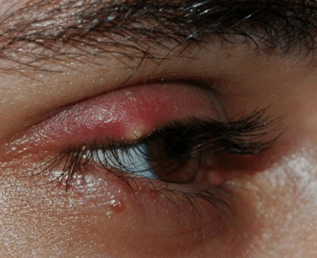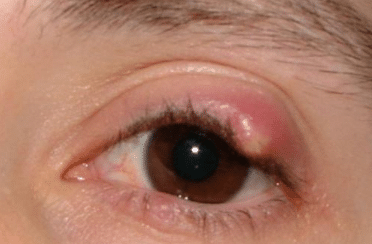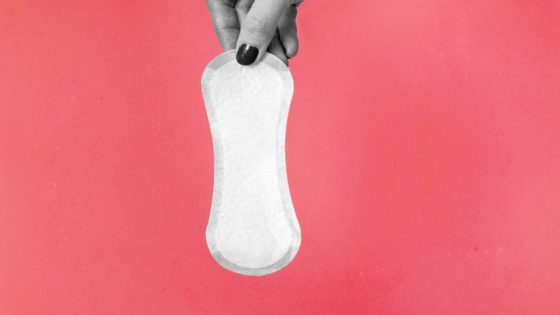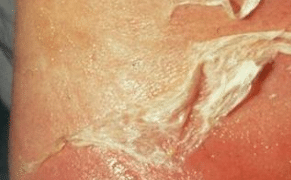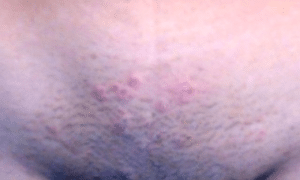Do you have white spots or dots under your eyelids? The appearance of small, tiny or little white spots or dots on eyelids may result from different underlying conditions. In this post, you will get insight into the causes of a white bump on eyelid, inside Eyelid, and underneath. You will also explore more on removal and treatment of such bumps.
Bump on Eyelid
Eyelid bumps are not something that you can blink at. Fortunately, they often disappear on their own. The most common type is normally a stye, a pimple like a bump on the lash line.
The inside of eyelids is normally lined with the special oil glands which usually keep the eyes lubricated.
Stye which form when the bacteria get into the glands, thus giving you a very painful and sometimes pus-filled bump. They might as well arise from an infection of the hair follicle.
The best move which can be taken is to wait it out, but you may also speed up the draining process through doing some warm compresses using a clean washcloth for about 15 minutes about three times a day.
Styes which can stick around for longer than a few days might require being drained by the doctor. Just don’t try to squeeze them yourself, which might spread the infection.
If the bump is like a hard lump that is under the skin, it might be a chalazion, which usually develops when an oil gland is blocked with the thicker than normal oil secretions or even by a stye which won’t heal. Chalazia are painless white dots under eyelids but might persist for several months.
Warm compresses are a very good remedy too, but if it doesn’t disappear or if it becomes much more painful (which is a sign it is infected), then your ophthalmologist might drain it.
Another culprit: milia, or even the small white bumps that are caused by the trapped keratin (which is a protein that is produced by skin) under an eyelid.
These may appear anywhere but normally show up around the eyes. Milia usually clear up on their own, but the doctor might scrape them away if they appear to be bothersome.
A lump which bleeds or even doesn’t disappear with treatment might be a skin cancer. Removal of the eyelid skin cancers might be very tricky, but your dermatologist can refer you to a surgeon who is trained micrographic surgery, in which the skin is removed by layers until a person is cancer-free. The good news is that it is highly effective and minimizes scarring.
Causes of White Bump on Eyelid
Cysts, styes and also the chalazion normally manifest as being small spots, bumps or even the pimples on and also around the eyelid.
A rash that is around eyelids might also start as white pimple-like bumps and then grow into several white spots on an eyelid. The below are some of the causes of a pimple on the eyelid.
Stye on eyelid
It is also known as the sty, happens when the edge of the eyelid is inflamed. It swells and then forms into a small, pimple-like growth on eyelid rim. A stye appears as red spots and might also develop outside or even inside of the eyelid.
According to research findings, if you have the blepharitis condition or even the eye redness, you are then more likely to get some styes. Other than blepharitis, these particular stye spots on eyelids are brought about by a staph bacterium.
The bacterium happens naturally in the nose of every person and can travel to an eye – internally, and lead to the pimple-like growth.
When brought about by a staph infection in an eye, the spots are usually contagious. But, Styes are usually not contagious, but rather they are a local infection or an inflammation of oil-producing glands of eyelids.
Chalazion
These are small white spots under eyelids. They form due to the blocked oil gland. Chalazion bumps might appear on upper and also the lower eyelid, or even both.
A blockage in a Meibomian gland on eyelid can lead to pimple-like bumps forming because of the trapped sebum that is under the skin, or even in the pore.
If a lot of sebum is produced and also trapped in the gland, the oil might also spread into surrounding tissue when the gland breaks. This will lead to an inflammation of the eyelid.
Milia
Milia cysts happen in groups which are under or above the eyelid. The cysts happen due to keratin that is trapped under the skin surface. If small spots that are on eyelids feel like hard bumps under the eyes, it is due to the keratin which is a strong protein. Keratin is usually found in nails, hair and also the skin tissues.
Milia bumps on eyelids are normally harmless. The dermatologist always let you understand that they will disappear on their own. In babies, milia spots are common but clear in a few weeks. If for esthetic reasons treatment is needed, then the options that are available are cryotherapy, laser removal of the milia, chemical peels and also dermabrasion.
Eyelid cysts or bumps
Cysts are very much common and they usually come from the bacterial infections. When a pore on eyelid waterline or even the rim is blocked, the buildup that is within the pore may harbor bacteria. An eyelid cyst will then appear as a pimple due to the fluid-filled sac.
Symptoms of white spots under eyelids which are brought about by cysts include redness, swelling and also hurting. Cysts are likely described by patients as a bump on the eyelid or even a yellow bump. This is due to the fact that bacterial activity in the growth produces a lot of pus.
Ocular rosacea eyelid bumps
People who suffer from the rosacea have a much higher chance of having the eyelid pimples. Ocular rosacea is inflammation which leads to redness, burning and also itching of eyes. The condition has a high prevalence amongst the people who flush easily.
Medications and home care tips might assist to remove ocular rosacea bumps. Temporary antibiotic prescriptions like erythromycin and tetracycline might assist heal the bump.
White Bumps underneath Eyelid
Yellow deposits can also form around eyelids as a side effect of the high levels of lipids which are in your blood. The medical term which is used for the deposits is xanthelasma.
These particular yellow spots are harmful initially, but they gradually worsen and lead to pain. They might also be an indication of a more serious underlying health problem.
Xanthelasma is the yellowish-white lumps of the fatty material that has accumulated under the skin on inner parts of upper and also the lower eyelids.
The plaques have lipids, or fats, which includes the cholesterol, and appear symmetrically and appear as white spots under eyelids and nose.
These lesions and also plaques don’t impair functions of eyelids. That implies they shouldn’t affect the ability to blink, or even open or closing of the eyes. They may then slowly become larger over time and lead to a lot of discomforts.
Usually, they don’t require to be removed unless they are uncomfortable or even for just cosmetic reasons.
Causes of xanthelasma
Anyone might have the cholesterol deposits around eyes. But this particular condition is common in people who have a lipid disorder known as dyslipidemia. People with this particular disorder have several lipids in the bloodstream, like the triglycerides and some forms of cholesterol.
You might also have dyslipidemia if you have any of the below conditions:
- Hypercholesterolemia, which is identified by total cholesterol that is greater than 200 milligrams per deciliter (mg/dL)
- Hypertriglyceridemia, which is normally identified by triglycerides that are above 150 mg/dL
- High levels of low-density lipoprotein (LDL), which is usually identified by LDL above 100 mg/dL
- High levels of high-density lipoprotein (HDL), identified by HDL above 40 mg/dL
White Bump inside Eyelid
A stye is a small and painful lump that is on the inside or even the outside of the eyelid.
As styes are usually brought about by a bacterial infection, doctors refer to them as being the infected eyelid cysts.
The medical name that is applied to a stye is a hordeolum.
Styes usually affect a single eye, but it’s also possible to have them in both of the eyes or even to have more of them in the same eye. Your vision is not affected.
The main symptoms are:
- A painful yellow lump on the eyelid
- Redness of the eyelid
- A watery eye, in several cases
Styes normally get better without any given treatment, especially after they burst open and release pus.
Don’t burst the stye by yourself. Go to see the doctor if you have a stye which is very painful with a swollen eyelid.
Types of stye
There are two general types of stye:
- An external stye (external hordeolum) – which is a swelling that develops on the edge of the eyelid; it might also turn into a yellow pus-filled spot which is very much painful to touch
- An internal stye – this is a swelling that develops on inside of eyelid; it’s less painful than an external stye
What causes a stye?
Styes are normally brought about by a staphylococcal infection. This particular bacteria normally live on the skin without leading to any harm.
External styes
A stye on the outside of eyelid might be brought about by an infection of:
- An eyelash follicle – these ones are small holes that are found in your skin that individual eyelashes usually grow out of
- The sebaceous gland – this particular gland is usually attached to eyelash follicle and thus produces an oily substance known as the sebum, which lubricates the eyelash so as to prevent it drying out
- The apocrine gland – this particular sweat gland empties into eyelash follicle and assists to prevent the eye from drying out
Internal styes
Internal styes can happen when the meibomian glands are largely infected. These particular glands are found on eyelids and produce an oily liquid, which then makes up part of tear film which covers the eye.
If meibomian glands are blocked, then a cyst can develop, which might be infected
Small, Tiny or Little Bumps on Eyelid
Milia are small bumps which happen under the outer skin layer of the eyelid, around the eyes and also the nose, including the cheeks. Sometimes known as “oilseeds,” these pearly white or even yellowish cysts normally appear in clusters and might also be in large areas of the face. Milia rarely become swollen or even inflamed.
White spots under eyelids happen most commonly in babies. In fact, they are usually found in nearly half of the full-term newborns. But, teens and also adults might thus be affected by milia.
Milia normally develop when the dead skin cells (keratin-which is a protein that is found in skin and hair) is trapped under the skin, thus forming a raised “pinhead” bump which appears similar to a white head.
Why this occurs is not fully understood, but it is not similar to acne, which is triggered by hormones and, unlike milia, leads to inflammation.
Sun damage might also be a contributing factor for the milia as it makes the skin rough and also tough, so it’s difficult for the dead cells to rise to the skin’s surface and thus shed normally.
The resulting clogs trigger milia formation. Sometimes, milia will eventually disappear without any kind of treatment; but they can also be persistent and thus stick around unless the steps are taken so as to get rid of them.
Milia also is closely associated with several other kinds of the skin damage — from an injury, medication or even the illness. These less common forms are known as the secondary milia.
Cholesterol Bumps on the eyelid
A xanthelasma is a yellowish deposit of cholesterol which is found under in the skin which is around or even on the eyelids. Xanthelasmata are not usually harmful, nor do they lead to any pain, but most of the people do not care the appearance of the yellow growths that are around the eyes and thus elect to have them removed.
Xanthelasma is a very much common condition that occurs among the elderly and those people of Mediterranean or also the Asian descent.
The condition happens slightly often in men than in women, normally in people over the age of forty
When the condition reaches some size and becomes very nodular, it is sometimes known as a xanthoma, but they are two distinct conditions; as the xanthoma is a much broader term that is used for a wider classification of the skin growths which happens anywhere on the body.
How to Get Rid of Bumps on Eyelid
White bumps under eyelids can dissipate on their own without any kind of intervention on your behalf, although there are several home remedies which can be tried to help to eradicate them much quicker, some of which are as listed below:
- Apply Honey
Honey contains great antioxidant properties, thus making it very much useful in the treatment of the white bumps under eyes.
Spread honey (use raw honey) onto the affected area and then leave it there for about 15 minutes, then wash it off using warm water. Repeat the process daily until an improvement is clearly noticed.
- Use Castor Oil
This oil contains antibacterial properties, amongst several other benefits which are related to healing. Apply about one-half of a teaspoon onto the affected area, and then allow the oil to soak in.
Repeat the process daily until the condition is completely eradicated. This might also be done in a similar manner, but with a mixture of equal measures of olive oil and also castor oil.
- Go for Sugar Scrub
Using a sugar rub might also assist to exfoliate the skin, and thus can be very much beneficial in the treatment of the white spots under eyelids. Grab half a lemon, and squeeze the juice out of it.
Mix the juice with some amount of the olive oil and some granulated sugar, and rub the mixture gently onto the affected area, leaving it for around 30 minutes before proceeding to wash it off. Repeat the process two times in a week for many months.
- Try Pomegranate Peel Powder
This powder contains natural exfoliating and also the antioxidant properties, and being full of vitamin C, implying that it is often used as a natural home remedy in the treatment of milia.
Simply roast the pomegranate peels until brittle and then crush to a powder mix it with some lemon juice. Gently apply the mixture to face, much leaving it for about 20 minutes before rinsing it using lukewarm water.
- Use a Good Exfoliating Product
There are several exfoliating products that are available to people wishing to treat white spots under eyelids. Apply the product to an affected area of skin, the exfoliating aspect will assist with the removal of the dead skin cells, and thus clear the white bump on the eyelid.
If you use the exfoliating moisturizer, the moisturizer can also assist to lessen the accumulation of the dead skin cells.
- Try Facial Sauna
A sauna assists to eradicate debris and also the dead skin cells from skin, and you do not need an actual sauna so as to get all the great benefits. Simply grab a towel and soak it in warm water.
Strain the excess water and place the warm towel on the face for 5 minutes. This might be repeated several times a day, and be performed on a daily basis so as to achieve the best results.
- Apply Retinol
Retinol contains exfoliation properties which can work to assist maintain skin clearness and also softness, which is the reason why it is used in the treatment of white spots under eyelids and also to fight the signs of aging.
Wash the face using clean water and wait for about 30 minutes before using a small drop of the retinol cream to affected area. Beware that the cream might also be harmful if it gets in eyes.
- Protect Your Skin from the Sun
Overexposure to sun rays can lead to the white bumps under eyelids worsening, implying that reducing the amount of time which you spend on the sun will be very much beneficial in assisting to clear the condition.
This is true when the milia have been brought about by blistering or sunburn, as further exposure can do nothing but only exacerbate the condition.
White Bump on Eyelid Cure
If you have very large white dots under eyelids, then your doctor might be required to puncture it so as to drain the infected fluid. If you keep getting the styes or even have ones that won’t disappear, your doctor can prescribe an antibiotic cream which may be to put on the eyelid.
Surgery can be an option if you have a very large chalazion which doesn’t disappear on its own. Your doctor can also give you antibiotic eye drops so as to use before and also after surgery to treat or even prevent infection.
This is normally done in a doctor’s office. Anti-inflammatory steroid injections can relieve some amount of swelling.
You might also have the condition surgically removed if its appearance is bothering you. Otherwise, no treatment is required.
Further references;
- White Bumps Under Eyes: http://www.newhealthadvisor.com/White-Bumps-Under-Eyes.html
- Everything You Should Know About Cholesterol Deposits in Your Eye: http://www.healthline.com/health/cholesterol-deposits-in-eye#overview1
- Stye: http://www.nhsdirect.wales.nhs.uk/encyclopaedia/s/article/stye/
- What Are Milia: http://www.allaboutvision.com/conditions/milia.htm
- Xanthelasma – How It’s Treated and Removed: http://www.eyehealthweb.com/xanthelasma/
- Eyelid Bump: http://www.healthline.com/health/eyelid-bump#overview1
- How to Get Rid of Cholesterol Deposits Around Your Eyes: http://www.top10homeremedies.com/how-to/get-rid-cholesterol-deposits-around-eyes.html


